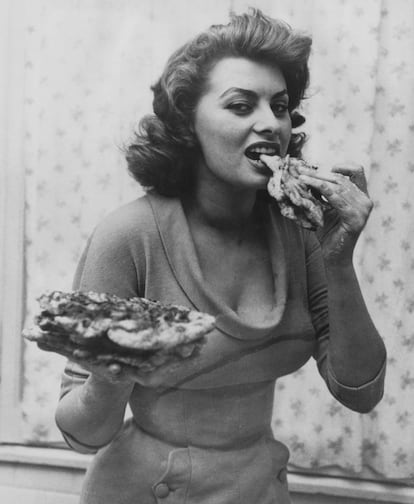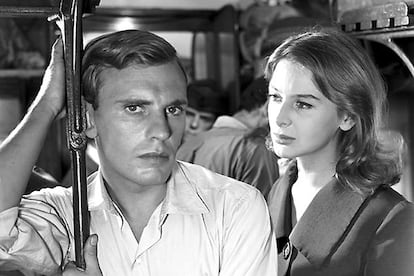Gina Lollobrigida and nine other divas and anti-divas from Italy’s golden age of cinema
The actress’s recent death inspired us to look back and reflect on an extraordinary era in Italian film, one that made its stars famous around the world

Gina Lollobrigida’s death on January 16, 2023, inspired us to look back and reflect on an extraordinary era of Italian cinema that spans the neorealism of the 1940s to the early 1970s. During that time, numerous directors with different styles brought Italy to life on the big screen, and the actresses became as well-known around the world as any Hollywood star. They were divas and anti-divas whose beauty, charisma and glamour left an indelible mark on world cinema.
This reminder of some of the most important female artists of the era may also encourage us to rediscover some classic titles, films that are in danger of being forgotten and stories worth revisiting; most can be found on streaming services like Amazon and Netflix.
Gina Lollobrigida (1927-2023)

Lollobrigida came to cinema through fashion and Italian popular beauty pageants. Her relatively brief 25-year career included Italian social dramas and comedies (Bread, Love and Dreams; Frisky); big American productions shot in Europe (Trapeze, Solomon and Sheba) and European co-productions that involved prestigious talent that were better on paper than in execution (Fanfan, la Tulipe; Imperial Venus; Woman of Straw). The latter is certainly her best-known work, but the former is far more relevant and includes three superb films in which Lollobrigida delivers wonderfully energetic performances: Mario Monicelli and Steno’s A Dog’s Life (1950), a tragicomedy about a variety troupe’s pitiful existence; Pietro Germi’s Four Ways Out (1951), a crime story with social overtones and moral misery, set during a robbery of the ticket office at the old Fascist National Stadium amid a soccer match, which included Federico Fellini and Luigi Comencini among its screenwriters; and Luigi Zampa’s The Woman of Rome (1954) based on Alberto Moravia’s magnificent novel about the complicated life of a prostitute.
Anna Magnani (1908-1973)

Magnani is the eldest of the group, although she coincided with the other leading Italian actresses of the 1950s and 1960s. The daughter of a working (and single) mother who was raised by her grandmother in a slum, she had suffering etched on her face. But she was a woman who could do anything. She wore history’s most attractive dark circles under her eyes and carried film’s most authentic voice tremor. She worked with the best and could do any style of staging and narration: She embodied the neorealist woman in Roberto Rossellini’s Rome, Open City; in Luchino Visconti’s Bellissima, she played the heartbreaking mother, who stubbornly turned her (ungraceful) daughter into a child prodigy of cinema; and in Pier Paolo Pasolini’s Mamma Roma, she was a bitter ember of neorealism that incorporated a touch of poetry. In 1955 she went to Hollywood to play her first English-language role in Delbert Mann’s The Rose Tattoo, based on the play by Tennessee Williams, her friend and confidant who had written the text with her in mind; she won the Oscar for best actress. “I always wondered how she managed to live within society and yet remain so free of its conventions,” the playwright wrote about Magnani in his memoirs.
Sofia Loren (1934-)

Sofia Loren is a living legend. She has won seven David de Donatello awards for best leading actress and an Oscar for Vittorio de Sica’s Italian film Two Women; she also received an honorary Academy Award in 1991. Her resume includes extraordinary films from Italy, Europe and Hollywood. At the age of 15, when she came in second at the Miss Italy contest, producer Carlo Ponti was one of the pageant judges that day. He asked her: “Why don’t you come to my office tomorrow?” The rest is Italian cinema – and family – history. Loren and Ponti, who was 22 years older than Sofia, married twice: first in 1957, by proxy in Mexico (the marriage was illegal in Italy because Ponti was still married to another woman); and definitively in 1966. They stayed together until his death. At the age of 16, Loren appeared nude in the French version of an Italian production, It’s Him!... Yes! Yes!; a surprising photo of it remains. From then on, she played roles full of personality and had the ability to act in any film genre, as evidenced in 1964, when she famously appeared in Yesterday, Today and Tomorrow, Fall of the Western Roman Empire and Marriage Italian Style. In 1994, in Robert Altman’s Prêt-a-porter, she appeared with Marcello Mastroianni in an homage to herself that recreated the striptease from Yesterday, Today and Tomorrow.
Monica Vitti (1931-2022)

Monica Vitti was the coolest, most modern, most mysterious and most anti-diva of the group. Unlike most of her peers at the top – who had sculpture-like bodies and cinematic beginnings enhanced by their looks and beauty pageants but little to no artistic training, which they circumvented with their passion, spontaneity and charisma – Vitti had graduated from the National Academy of Dramatic Art in 1953. Perhaps Vitti’s beauty was more Nordic than Mediterranean. In any case, she will go down in Italian cinema history for her depictions of languid and glacial women in the films of her real-life partner, Michelangelo Antonioni: The Adventure, The Night, The Eclipse, Red Desert. Although she made a good number of popular comedies in the second part of her career (The Girl with a Pistol, The Pizza Triangle...), she seemed more limited in those roles. However, the alienated woman with her lost gaze in Antonioni’s films fit perfectly into Buñuel’s surrealism; she starred in one of the best episodes of his brilliantly demented The Phantom of Liberty.
Silvana Mangano (1930-1989)

Although she had already appeared in a handful of films, her performance at 19 in Giuseppe de Santis’s Bitter Rice (1949) provided one of Italian cinema’s most enduring images: an overwhelmingly sensual woman with a round body wearing short pants, threadbare stockings and a defiant look on her face, working hard as a peasant. The film candidly depicted harsh social conflict: the confrontation in the rice fields between women working in their country of origin versus undocumented immigrant women. That wasn’t the only memorable scene in Mangano’s career. Her movements on the stage in Alberto Lattuada’s Anna (1951), and her singing and dancing in El negro zumbón, were the living image of emotional ecstasy; Nanni Moretti paid tribute to them in Dear Diary. Later on, she made landmark titles such as Theorem, Death in Venice and Dune in the USA. She also appeared in less popular but marvelous works such as The Great War, The Verona Trial and Conversation Piece. At 16, she was chosen to be Miss Rome, and the following year she was one of the favorites to be Miss Italy, but Lucía Bosé won. She lived incognito in Madrid, Spain, for the last three years of her life and is buried in the Almudena cemetery.
Giulietta Masina (1921-1994)

Giulietta Masina was different from those who came before and after her. She was petite, didn’t meet contemporary beauty standards and had earned a degree in philosophy and letters. She got her start in theater and radio, where she met Federico Fellini, her man both in life and in cinema. When they met, Fellini was writing scripts for serial shows. Although she worked with fundamental directors of Italian cinema (Roberto Rossellini, Lattuada, Luigi Comencini, Carlo Lizzani, Lina Wertmüller...), her performances in Fellini films – The Swindlers, Nights of Cabiria, Juliet of the Spirits, Ginger and Fred – demonstrated her naturalness, genius and delicacy. Her awkward ditty, in which she plays the drums and timidly shouts “Zampanò has arrived!” in La strada never ceases to distress no matter how many times one sees it. Masina could be clownish and ladylike, apoplectic and wrathful. She was a force of nature with multiple interpretative registers. She survived her husband by only five months. The couple had only one child, who died a month after birth; prior to that, Masina suffered a miscarriage after she fell down a flight of stairs.
Eleonora Rossi Drago (1925-2007)

She was a favorite to win the 1947 Miss Italy beauty pageant but was disqualified after the contest organizers found out that she had been married and had a child; beauty pageants were morally nefarious affairs. Palmira Omiccioli, Rossi Drago’s real name, was also active in the fashion industry. Of the actresses discussed here, Rossi Drago is surely the most unknown of the group. Nevertheless, this writer is convinced that she deserves recognition for Antonioni’s The Girlfriends as well as two other lavish films: Valerio Zurlini’s Violent Summer, in which she played a beautiful bourgeois widow who began a relationship with a young man amid the Second World War, but the film was set in a microcosm far removed from the conflict; and Pietro Germi’s gritty crime thriller The Facts of Murder. Supremely elegant and beguiling, she also worked in Spain. She appeared in Nieves Conde’s El diablo también llora (The Devil Also Cries) and in Pere Balañá's excellent El último sábado (Last Saturday). The press referred to her as “the lady” of Italian cinema.
Lucia Bosé (1931-2020)

Bosé was married to Spanish bullfighter Luis Miguel Dominguín, her children are well known in Spain for their public and artistic careers, and she starred in Death of a Cyclist, a classic of Spanish cinema. However, her Italian films are not as popular. Story of a Love Affair (1950), Antonioni’s magnum opus and Bosé's most important, showcased her as an elegant and cold bourgeois woman in film after she won the Miss Italy contest at 16 years old. The beauty pageant Bosé won was a historical one, in which future actress Gianna Maria Canale placed second and Lollobrigida third; Mangano also participated in the contest and it was the same one from which Rossi Drago was disqualified. Bosé worked with Antonioni again in The Lady without Camellias (1953) and gave what was surely her best performance in Francesco Maselli’s splendid Abandoned (1955), a movie about the class conflict and love between a young aristocrat and Bosé's working-class refugee, during the Second World War. The following year she left her acting career to devote herself to her family. After she divorced Dominguín in 1967, she resumed her career, although she acted more in Spain than in Italy. The best of the Italian films was Mauro Bolognini’s Metello.
Claudia Cardinale (1938-)

With a career as broad as her smile, Cardinale worked in all types of movies and genres. She remains active today at the age of 84. Some of her best-known titles include Visconti’s Rocco and His Brothers and The Leopard; Fellini’s 8½; Sergio Leone’s western Once Upon a Time in the West; and in the USA, Blake Edwards’s The Pink Panther and Richard Brooks’s The Professionals. She also appeared in German director Werner Herzog’s Fitzcarraldo. But some of her lesser-known roles are just as interesting or even more so: the misguided country girl in love with a bourgeois man who ends up spending the day of her life with his younger brother in Zurlini’s painful Girl with a Suitcase; the young lady from a ruined bourgeois family, who begins an affair with her mother’s lover in Maselli’s Time of Indifference, based on Moravia’s novel; Mastroianni’s dissatisfied wife in Mauro Bolognini’s masterpiece Il bell’ Antonio; and the wife of a missing man, presumably murdered by the Sicilian Mafia, in Damiano Damiani’s Mafia, one of the best films about the Cosa Nostra ever made. Born in Tunisia, Cardinale got her start in cinema through a beauty pageant in the North African country.
Stefania Sandrelli (1946-)

She made her debut at the age of 15 in The Fascist (1961), Luciano Salce’s magnificent comedy about fascism. That same year, in Germi’s popular satire Divorce Italian Style, the baron played by Mastroianni fell madly in love with his niece, played by Sandrelli. Soon after, she cemented her status as a young star in another Germi comedy about Italy’s very particular moral and social norms, the fantastic Seduced and Abandoned (1964). Endowed with a delicate face and voice, a strange finesse, and a forceful body, Sandrelli has worked with directors of all kinds, including the erotic Tinto Brass in The Key. Her most important films are the political The Conformist (1970) and 1900 (1976), both by Bernardo Bertolucci; the beautiful portrait of a generation in Ettore Scola’s We All Loved Each Other So Much (1974), the director with whom she also made The Terrace and The Family, and, of course, her role as a mature and sexy woman in Bigas Luna’s Jamón, Jamón. Antonio Pietrangeli’s I Knew Her Well (1965) was one of her weaker films. Still active as an actress, Sandrelli also directed a 2009 film starring her daughter Amanda: Christine Cristina, about the 15th century philosopher Christine de Pizan, considered to be a precursor of Western feminism.
Sign up for our weekly newsletter to get more English-language news coverage from EL PAÍS USA Edition
Tu suscripción se está usando en otro dispositivo
¿Quieres añadir otro usuario a tu suscripción?
Si continúas leyendo en este dispositivo, no se podrá leer en el otro.
FlechaTu suscripción se está usando en otro dispositivo y solo puedes acceder a EL PAÍS desde un dispositivo a la vez.
Si quieres compartir tu cuenta, cambia tu suscripción a la modalidad Premium, así podrás añadir otro usuario. Cada uno accederá con su propia cuenta de email, lo que os permitirá personalizar vuestra experiencia en EL PAÍS.
¿Tienes una suscripción de empresa? Accede aquí para contratar más cuentas.
En el caso de no saber quién está usando tu cuenta, te recomendamos cambiar tu contraseña aquí.
Si decides continuar compartiendo tu cuenta, este mensaje se mostrará en tu dispositivo y en el de la otra persona que está usando tu cuenta de forma indefinida, afectando a tu experiencia de lectura. Puedes consultar aquí los términos y condiciones de la suscripción digital.
More information
Archived In
Últimas noticias
Welcome to the post-religion era: The idea of Christianity as the absolute truth has become obsolete
‘I thought you would like it’: The risky sexual practice popularized by TV shows and TikTok
The digitalization of tourism: ‘They promise experiences and gave us the worst possible one’
Mexican peso defies uncertainty with forecasts of a new period of stability in 2026
Most viewed
- Sinaloa Cartel war is taking its toll on Los Chapitos
- Oona Chaplin: ‘I told James Cameron that I was living in a treehouse and starting a permaculture project with a friend’
- Reinhard Genzel, Nobel laureate in physics: ‘One-minute videos will never give you the truth’
- Why the price of coffee has skyrocketed: from Brazilian plantations to specialty coffee houses
- Silver prices are going crazy: This is what’s fueling the rally











































